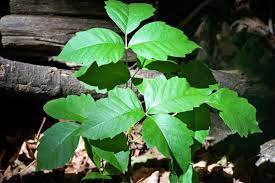Events:
Online Bee School Columbia County Oregon Beekeepers will join Tualatin Valley Beekeepers Association for their online Bee School March 18, 19, and 21. Then we will have our own Field Day on April 6th or 15th depending on the weather in Trenholm. For registration contact Linda Zahl [email protected].
A plant to avoid: Poison oak
Poison oak (we don’t have poison ivy) is more common than people realize in South Columbia County. While it is a native deciduous plant (one that loses its leaves in the fall), it is not one to encourage. It is often found in the rocky, basalt zones in St. Helens but can also grow in Warren and Scappoose. Birds consume poison oak’s berry-like fruit and move seed around.
Poison oak grows in many forms. It can be a soil-hugging or tree climbing vine, a medium sized shrub (3-7 feet tall) or rarely, a small tree. Poison oak can develop thickets through root systems that produce “suckers” that grow into new stems.
Even its coloration can be confusing. When poison oak leaves first emerge in the spring, they are a darkish brown/purple but soon become glossy green. In the fall, they turn a brilliant red-orange. The leaves are borne in clusters of three “leaflets” and many of us were warned as children, “leaves in threes, leave them be.”
The sap of poison oak is strong dermal toxin with individual reactions that vary from none to extreme blistering. Sensitive people often have severe breathing issues when they inhale smoke from burning poison oak. All parts of the plant are toxic, even the winter leafless stems. People can also develop a reaction to poison oak after many years of immunity to the plant. So it is not a good plant to have around.
I do not know of a non-chemical control for poison oak except careful hand digging (and possibly goats, who seem to like it). If you cut it, it will send up new shoots. Don’t burn it as the smoke is very dangerous to sensitive people. The herbicides glyphosate (best known under the trade name Roundup) and triclopyr (sold as Crossbow and some “brush killer” formulations) work well, particularly after early June. Get good coverage on the leaves and do spot treatments for the stems that survive (also read and follow all label instructions). Be careful about using either product when it is windy and triclopyr products when it will be warmer than 77 degrees for 24 hours after it is applied to avoid non-target plant injury. Remember, the killed stems may cause skin reactions until they finally decay. If you have questions, please contact me (see above). Here are some links for more information: https://extension.oregonstate.edu/gardening/flowers-shrubs-trees/how-remove-poison-oak-plants-treat-rash.
https://extension.oregonstate.edu/catalog/pub/pnw-108-pacific-poison-oak-western-poison-ivy-identification-management.
Hot and not so hot topics for this spring
Frustrations with a cold, wet spring: The consequences of the persistent rain and chilly weather played out in fields or gardens that haven’t been and shouldn’t have been tilled yet (as of this writing). Patience is a virtue when working our saturated clay soils, which we have lots of, since wet rototilling can lead to clods that refuse to die. That isn’t good for planting seeds.




